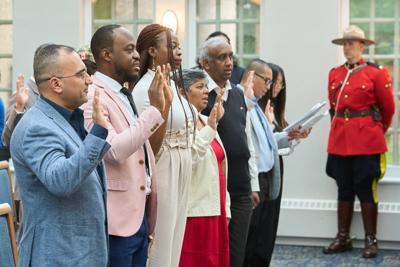TORONTO - Despite polls showing many Canadians were worried about the effects of immigration on housing and affordability late last year, the topic has scarcely been mentioned in the federal election campaign now drawing to a close.
Several public opinion polls conducted late last year suggested most Canadians believed immigration levels were too high.
While the Liberals, Conservatives and NDP all have plans to address immigration levels after the election, the issue has taken a back seat to more pressing threats, like U.S. President Donald Trump’s global trade war.
Zool Suleman, a Vancouver-based immigration lawyer, said it’s “shocking” that immigration has received so little attention during the campaign, given how heated the debate over immigration levels was in the months leading up to it.
“With the changes in the government to the south of us, all of a sudden all eyes have tilted to that,” Suleman said. “And so the immigration issues are a very low priority and not getting much attention, which I think is going to be a big problem once the election is over.”
He said those “issues” include long processing times for permanent residency — which may be aggravated by the current immigration plan, which reduces the number of temporary visas issued by 10 to 20 per cent, depending on the type.
“These would mainly be students and workers. They’re facing deep frustrations because processing times are expanding from months to years, their visas are running out and they’re not aware of what to do in terms of their legal status in Canada,” Suleman said.
“So unless this is dealt with very quickly, we’re going to end up having a very large out-of-status population of temporary people in Canada.”
All major parties have agreed during the campaign that Justin Trudeau’s government allowed immigration levels to become unsustainable.
The Liberals are promising to cap the number of student and worker visas at less than five per cent of the Canadian population, and to limit permanent resident admissions to less than one per cent of the population, by the end of 2027. The Liberal platform says this would help “ease the strain” on housing, infrastructure and social services.
The Conservative platform says the party would tie immigration levels to available housing, health care resources and the job market. The document says this would ensure immigration is “fair” for both Canadians and newcomers.
The Conservatives also say they plan to require that employers consult with relevant unions before approvals are granted to bring in temporary workers, and to introduce criminal background checks for student visa applicants, among other measures.
The NDP platform doesn’t mention immigration. While campaigning in Vancouver on Tuesday, NDP Leader Jagmeet Singh said that immigration is essential to growing the economy but must be kept in line with what the labour market needs.
“There are certain things that I want to see changed or ended entirely. The exploitation of temporary foreign workers that is so pernicious and prevalent is something that has to stop. It just drives down wages and exploits those workers,” Singh said.
Ali Bhagat, an assistant public policy professor at Simon Fraser University, said he believes both the Liberals and Conservatives are ducking the issue to avoid drawing comparisons with U.S. President Donald Trump’s crackdown on the undocumented.
“They want to stay clear of that conversation because in the pro-immigration side, you start to boil the blood of some voters that have been anti-migrant and have been fed that rhetoric for quite a bit, and if you’re anti-immigrant, then you start sounding like Trump,” he said.
Bhagat said the parties have done voters a “disservice” by leaving immigration out of their campaign pitches.
“The two major parties … they’re basically the same. And I think it’s important for us to know that,” he said.
Canada’s economic growth relies on continued immigration. Suleman said Canada needs a discussion about what the future of immigration looks like long-term, as the country adjusts to Trump’s tariffs.
“I think that’s where the robust discussion needs to take place. Where exactly does Canada want to be, say, 10 years from now? And I think we need that discussion,” he said.
This report by The Canadian Press was first published April 26, 2025
Error! Sorry, there was an error processing your request.
There was a problem with the recaptcha. Please try again.
You may unsubscribe at any time. By signing up, you agree to our and . This site is protected by reCAPTCHA and the Google and apply.
Want more of the latest from us? Sign up for more at our newsletter page.

























To join the conversation set a first and last name in your user profile.
Sign in or register for free to join the Conversation